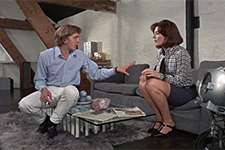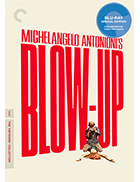Blow-Up
|  Michelangelo Antonioni’s Blow-Up is an intriguing, frustrating, compelling film—pretty much exactly what I imagine Antonioni wanted it to be. A murder mystery that offers no solutions, it takes place over a single day and is framed as a “day in the life” portrait of a facile young photographer who thinks he is in control of his world, but learns that he is like a speck of paint on a huge abstract canvas. Antonioni had always been fascinated by landscapes and spaces, and in late 1960s London he found a particularly evocative location that embodied the profound cultural shifts that were occurring at the time. Even if Blow-Up doesn’t work for you on a narrative or thematic level, it still functions as a fascinating portrait of “Swinging London,” as defined by Time magazine in its April 15, 1966 cover story: “In a decade dominated by youth, London has burst into bloom. It swings; it is the scene.” And at the center of that swinging scene is a handsome young photographer named Thomas (David Hemmings), who we first see walking bleary-eyed with a group of scruffy, mostly homeless men out of a foss house (a cheap nightly lodge for the indigent). But, then he gets in his Rolls Royce convertible, and soon he is back at his trendy warehouse studio, straddling the lithe body of a barely clothed model (Veruschka von Lehndorff), capturing her with his camera lens for a fashion shoot. It is a moment of pure control for him, with Veruschka doing his every bidding as he treats her like an object to be captured and transformed by his artistic consciousness, a point that is driven home with even more force in a subsequent scene in which he shoots a group of models posed around translucent sheets of colored plastic. The manner in which he barks orders, aggressively repositions their limbs, and berates them suggests that he is someone who, despite his youthful appearance and sullen eyes, relishes the control he exerts over his world, a control that he will soon learn is not, if not exactly illusory, significantly diminished in the wider context of existence. For its first half, Blow-Up has little or no plot to speak of as it documents Thomas’s daily routine—photographing models, smoking pot, visiting an antique shop and buying a massive wooden plane propeller, meeting with his agent about a book deal. At one point, he goes to a park to take some photographs, and he ends up capturing the activities of two lovers who he first spots walking up a flight of concrete steps to a more secluded area. He hides behind bushes and trees, snapping pictures of them as they embrace and talk in an open grassy space that takes on the appearance of a stage. Again, Thomas is in control, playing the voyeur as he turns unsuspecting people into images (one can’t help but think of Jeff in Hitchcock’s Rear Window). When the woman (Vanessa Redgrave) sees him taking the pictures, she runs over and demands with no small degree of desperation that he hand over the film. He refuses, and later she comes to his studio and attempts to seduce him. When that doesn’t work, she tries to steal the camera with the roll of film still in it, but all to no avail. When Thomas finally develops the roll and begins scrutinizing the shots, he realizes that he inadvertently captured what appears to be a murder. The wordless sequence in which he discovers the murder by progressively enlarging portions of the image that contain vital visual information that escaped his eye when he was taking the pictures is a self-contained masterpiece of directing and editing. Without dialogue or extradiegetic music, Antonioni conveys an acute sense of discovery, inviting us to look over Thomas’s shoulder as the murder is revealed. Like Thomas, we start scrutinizing and questioning what we see, and Antonioni masterfully cuts among the still images to produce a seemingly animated narrative of betrayal and murder that may or may not have happened as Thomas imagines it. Later that night, Thomas returns to the park and discovers the body, proving that the grainy, almost abstract images weren’t just feeding his imagination. And now, the questions: Who was the victim? Why was he killed? Who killed him? Was the woman involved? If she was, how so? What was her relation to the victim? What eventually happens to his body? But none of these questions are ever answered. Not a single one. Antonioni has no real interest in answering them, just as he had no real interest in solving the mystery of the woman who suddenly vanishes in L’Avventura (1962), the film that established him as a paragon of moody European art cinema. As Antonioni told film critic Roger Ebert in a 1968 interview, Blow-Up is “not about a murder but about a photographer.” While that assessment is somewhat facile and misleading—the entire second half of the film, after all, is driven by Thomas’s investigation and subsequent attempt to alert others to the murder—it also points to Antonioni’s tendency to look through and past the conventions of traditional narrative cinema. Blow-Up is very much about Thomas and the rude awakening he experiences when his shallow world of material comfort and artistic power is shattered by larger forces at work over which he has no control. But, Antonioni is also clearly interested in the world Thomas inhabits, the “Swinging London” that was the at the epicenter of a youth-driven revolution in art, music, and fashion. Hence, the prominent role of Thomas’s neighbor, an abstract painter whose Jackson Pollack-like splatter canvases come to reflect the increasingly abstracted blow-ups Thomas makes; the copious attention that Antonioni pays to the details of Thomas’s fashion shoots; the presence of various protestors; a group of radical mimes that appears at the beginning and end of the film; and a scene that takes place in a studio-recreation of the infamous Tiki Club featuring The Yarbirds doing their best Pete Townsend impersonation (Antonioni had wanted The Who for the scene, but couldn’t land them). Blow-Up was the first of three English-language films Antonioni directed under a deal with producer Carlo Ponti (the others being 1970’s Zabriskie Park and 1975’s The Passenger). He shot the film with cinematographer Carlo Di Palma, who had also shot Antonioni’s first color film Red Desert (1964) and would go on to shoot 10 of Woody Allen’s films from the mid-1980s through the late 1990s. As he did on Red Desert, Antonioni wanted complete control of the film’s color scheme, to the point that he had buildings painted different colors, the street darkened, and the grass in the park given a brighter shade of green. The result is a film that often looks like a piece of pop art, albeit one overcast by gray and gloomy skies. The imagery is somehow simultaneously bright and glum, which reflects the film’s thematic duality torn between the exciting surface of London in the mid-’60s and the more mundane realities of poverty, political discord, and, of course, death. In a conventional murder mystery, the investigation would take center stage to the exclusion of everything else, but in Blow-Up Thomas is constantly distracted by the world around him. Right after he first discovers that his camera has captured a murder, he aggressively initiates a ménage-a-trois with a pair of giggling would-be models (Jane Birkin and Gillian Hills). It is his last moment of true control in the film, as he flips their desire to use him to further their modeling careers into a carefree afternoon of easy sex after which he expels them from his studio (the scene’s unadorned eroticism and brief flashes of full frontal nudity were enough that the film was denied a Production Code Seal of Approval in the U.S., and when MGM went ahead and distributed it anyway, the Production Code system collapsed, paving the way for the institution of an age-based ratings system). Later, when Thomas tries to convince his stoned agent about the murder at a party, he is met with nothing but indifference. Thus, while Thomas’s world is “hip” and “cool,” it is ultimately destructive. No one cares when a man is murdered; it’s just on to the next party. Questions don’t need to be answered; only immediate gratification is of importance.
Copyright © 2017 James Kendrick Thoughts? E-mail James Kendrick All images copyright © The Criterion Collection / Warner Bros. | |||||||||||||||||||||||||||||||
Overall Rating: 


 (3.5)
(3.5)


